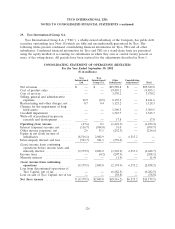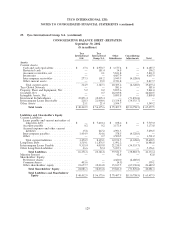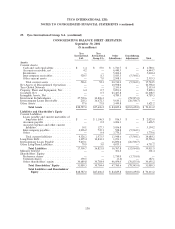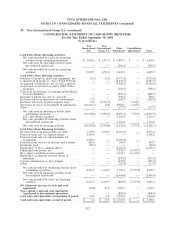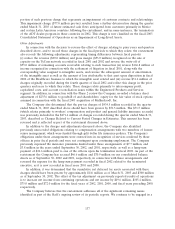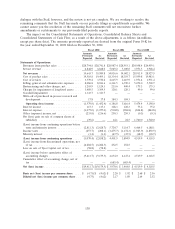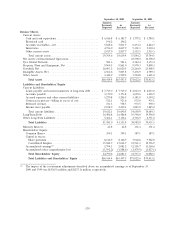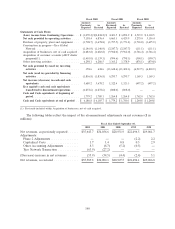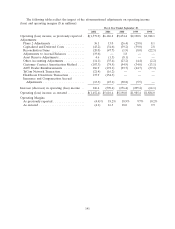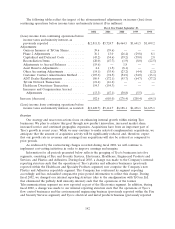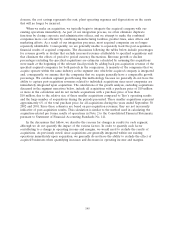ADT 2002 Annual Report Download - page 137
Download and view the complete annual report
Please find page 137 of the 2002 ADT annual report below. You can navigate through the pages in the report by either clicking on the pages listed below, or by using the keyword search tool below to find specific information within the annual report.preceding our prior Chief Executive Officer’s resignation in June 2002, the Company’s prior
management engaged in a pattern of aggressive accounting which, even when in accordance with
Generally Accepted Accounting Principles, was intended to increase reported earnings above what they
would have been if more conservative accounting had been employed. The report also noted that this
pattern may have had the effect of reducing the clarity and effectiveness of the financial statements in
conveying to investors the most accurate picture of our operations and may affect the comparability of
our historical financial results to our current and future results of operations. While most of the
matters identified by the investigation as ‘‘aggressive accounting’’ were determined by the Company, in
consultation with its auditors, to be in accordance with Generally Accepted Accounting Principles,
there were certain adjustments identified as relating to years preceding fiscal 2002. Such adjustments
were initially recorded in the first quarter of fiscal 2002, and have now been included as part of the
current restatements discussed below. See also Item 14. ‘‘Controls and Procedures’’.
Restatement—As previously disclosed, we have been engaged in a dialogue with the staff of the
Division of Corporation Finance of the U.S. Securities and Exchange Commission (the ‘‘Staff’’) as part
of a review of our periodic filings. We believed that we had resolved the material accounting issues at
the time of the original filing of our Form 10-K for the year ended September 30, 2002. Subsequent
correspondence and discussions with the Staff, principally regarding the method of amortizing contracts
acquired through our ADT dealer program as well as the accounting for amounts reimbursed to us
from ADT dealers, coupled with issues related to prior periods identified during our intensified internal
audits and detailed operating reviews in the quarter ended March 31, 2003 have led us to restate our
consolidated financial statements for the quarters ended March 31, 2003 and December 31, 2002, and
for the fiscal years ended September 30, 2002, 2001, 2000, 1999 and 1998.
The restatement principally relates to (i) recording charges in the prior years and quarters to
which they relate, rather than in the period such charges were initially identified, (ii) a revision in the
method of amortization used to allocate the costs of contracts acquired through our ADT dealer
program so that the amortization of such costs better matches the pattern of revenue related to such
contracts, (iii) a revision in the method of accounting for amounts reimbursed to us from ADT dealers
as part of the ADT dealer program to effectively treat such amounts as an integral part of the purchase
of the underlying contracts, and (iv) certain other adjustments regarding charges or credits so as to
record them in earlier accounting periods to which they relate. Each of these matters are described
further below:
Charges Relating to Prior Years Initially Recorded in Fiscal 2002
As disclosed in the Company’s previously filed Form 10-K for the fiscal year ended September 30,
2002, the Company identified various adjustments during the fourth quarter of fiscal 2002 relating to
prior year financial statements. These adjustments, which aggregated $261.6 million on a pre-tax basis
or $199.7 million on an after-tax basis, were recorded effective October 1, 2001. The adjustments
primarily were related to reimbursements from ADT dealers in years prior to fiscal 2002 in excess of
the costs incurred, a lower net gain on the issuance of TyCom shares previously reported for fiscal 2001
and adjustments identified both as a result of the Phase 2 review and the recording of previously
unrecorded audit adjustments (which were more appropriately recorded as expenses as opposed to part
of acquisition accounting). The restatement includes adjustments to reverse the charges recorded in the
first quarter of fiscal 2002 and present those charges in the historical periods to which they relate.
Charges Relating to Prior Years and Quarters Recorded in the Quarter Ended March 31, 2003
As disclosed in the Company’s previously filed Form 10-Q for the quarter ended March 31, 2003,
the Company conducted intensified internal audits and detailed controls and operating reviews that
resulted in the Company identifying and recording pre-tax charges of $434.5 million in that quarter for
charges related to prior periods. These charges resulted from capitalizing certain selling expenses to
property, plant and equipment and other non-current assets, mostly in the Fire and Security Services
segment, and reconciliation items relating to balance sheet accounts where certain account analysis or
135



